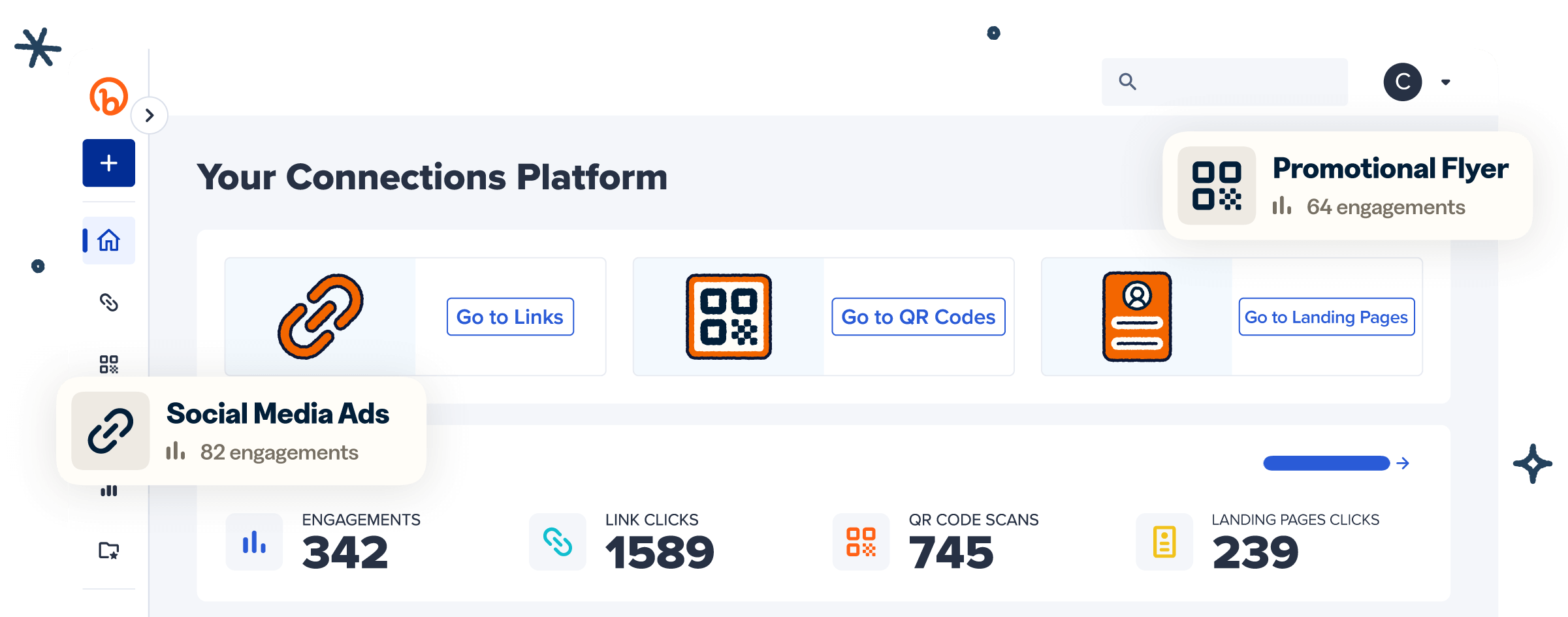Imagine that your marketing team creates awesome content for a newly launched product or service so your sales reps can use it in their marketing efforts. You suggest using different marketing materials to attract target customers and increase your return on investment (ROI). However, despite your efforts, you notice the results are far from what you expected, and your marketing channels are underperforming.
That’s where tracking marketing collateral helps. You can get real-time analytics of your marketing materials to know which ones favor your sales reps and clients. But how exactly do you do that? This article explores marketing collateral and how to track it for fast business growth.
What is marketing collateral?
In digital marketing, there’s always a need to communicate your business’ brand message to existing and potential customers. Marketing collateral is any media you use to do this—from print materials like business cards and flyers to digital marketing tools like catalogs and social media.
As an extension of your content marketing efforts, marketing collateral aims to inform, educate, and guide the target audience on how your products and services can solve their problems.
There are different types of marketing collateral you can use, depending on the target audience, goals, and budget. They include the following:
- Blog posts: You may use a piece of content to educate prospects on a particular topic relating to your audience. Quality and well-written posts define your business as a thought leader in the industry, building more trust with current and potential customers.
- Landing pages: These provide clients with additional information about your products and services while persuading them to take a specific action—for instance, filling out a consultation form.
- Webinars: You may use an online presentation or seminar—live or pre-recorded—to educate your clients about what you offer.
- Infographics: If you want to convey information to your customers through storytelling, infographics could be a solution for you. They’re essential if you have complex topics to break into easy-to-digest formats.
- Case studies: They explain the successful experiences you’ve had with existing or previous customers—for instance, the challenges you encountered and the strategy your team members used to overcome and meet expectations. This may convince prospects to commit to your business and help you beat the competition.
- Brochures: They demonstrate the crucial details about your business, like the products and services you offer, their features, and why customers should buy them.
- Magazines: You can use brand magazines to share details about your business, connect with your customers through shared interests, and drive them into action.
Other types of marketing collateral you can use include white papers, direct mail, eBooks, and podcasts.
Tips for organizing and managing marketing collateral
Now that you know what marketing collateral is and the types you can use to support your marketing campaigns, how do you stay ahead of the curve? By keeping track of marketing trends and effectively organizing and managing your collateral. Here are some tips for effective marketing collateral management:
Catalog existing collateral
Effective marketing and sales collateral is the backbone of all other marketing efforts. Therefore, ensure you’ve established an inventory of all marketing collateral items, including details like formats, purpose, target audience, and usage metrics.
In addition, centralize your collateral for easy access and brand consistency. For example, arrange e-books by the newest version so your marketing team can quickly locate them. This also prevents sending incorrect or outdated files to clients or stakeholders.
Establish clear brand guidelines
Maintaining consistent brand messaging and visuals makes it easy for potential customers to recognize your business across all marketing mediums. So, create and update brand guidelines and ensure they are accessible to all team members.
Review and update collateral for marketing campaigns
Reviewing and updating your collateral items is as important as centralizing them. Set up a regular schedule to review and update your marketing materials to ensure they are current and effective.
Retiring outdated and underperforming collateral reduces the risk of wrongly branding marketing materials while safeguarding your brand consistency.
Streamline collaboration and approval processes
Implement processes that facilitate team collaboration, streamline content creation, and expedite approval workflows to ensure timely and consistent collateral production. For example, define and assign roles to your team members and establish a brief that discusses your objectives, deadlines, and target audience.
Use technology to make things easier
Leverage digital asset management systems to ensure effective organizing, storing, and sharing of marketing collateral. Before you settle on a collateral management software to use, consider whether it:
- Is compatible with existing tools.
- Works well with devices like tablets, smartphones, or laptops.
- Provides advanced search capabilities.
- Offers granular analytics to track how an asset is shared and its contribution to the sales process.
How to track your marketing collateral with Bitly
Bitly provides a structured way of tracking, finding, and collaborating your sales and marketing collateral. With this tool, you can get insights into your content’s performance, i.e., how many people view it and how it’s supporting your marketing campaign.
Here’s how to utilize the tool:
Set up Bitly for collateral tracking
Tracking links can help you understand the performance of your digital marketing collateral and its role in your brand’s growth. The following are steps for creating tracking links for different pieces of digital collateral with Bitly:
- Sign up or log in to your Bitly account.
- Select the Create New button at your top left corner.
- Enter your long link into the Destination box.
- Customize the URL by adding a custom back-half or title. You can also fill in other fields relevant to your inquiries.
- Select the Create button.
To set up branded links that will enhance brand visibility and trust:
- Select Settings on the left top of your Bitly Dashboard.
- Tap Custom domain, then add the domain.
- Depending on your subscription plan, you may use your own domain or the standard bit.ly domain.
- Follow the guidelines to update your URL’s DNS setting.
You can view the verification status of your added domain under the custom domain in the settings tab.
View your engagement data through Bitly Analytics
Use the Bitly Analytics dashboard to learn more about the audience engaging with the collateral, such as geographic location, device type, and referral sources.
To view engagement data on the links page:
1. Log in to your account and select Links on the left-hand side.
2. Select your link. (You can also use search or filters to locate it.)
3. View the total engagements from the top of the page.
4. Scroll down for more details on your link’s performance over time.
Optimize collateral based on performance data
Bitly provides clicks by location, allowing you to identify demographics to focus on in future campaigns.
You can also split test to compare the different versions of collateral and see what resonates best with the target audience.
Integrate Bitly with other marketing tools
Bitly integrates with marketing tools and platforms such as the following for a cohesive tracking strategy:
- WordPress
- Sprout Social
- Google Sheets
- Hootsuite
The integration allows you to have a comprehensive view of the performance of your digital marketing collateral.
Bonus: Tracking how the sales team uses your marketing collateral with Bitly
While marketing teams are all-in on content, sales teams are mostly not. In fact, 90% of marketing collateral goes unused by sales. That’s right. Sales will probably only use one of every 10 pieces of content you make.
Since teams work out of silos, it can be hard for marketing to keep sales up to date with the latest content when reps are busy trying to close deals. The team might meet with marketing once a month to get an update about new collateral, but the next day, they’re back on the phones. Messaging, collateral, and especially the latest blog post are all forgotten.
If you want your sales teams to use the content, you have to know what they’re using so that you can keep optimizing and promoting. That’s where Bitly can help. With Bitly Campaigns, you can build a dashboard showing which content pieces are most popular among sales reps. That helps show which pieces you might need to promote more and which are most popular.
Here’s how:
Create channels for each rep
Create channels for each rep on the team. The best way to do this is to create a channel with each rep’s name so that it’s easy to review at a glance when tracking content usage across the team.
Here’s how you can add a channel to your campaign:
1. Log in to your Bitly account and tap Campaigns on the left sidebar.
2. Select the campaigns you want to edit and pick Manage Channels.
3. Enter the channel name you wish to add and tap Create a new channel. This will automatically add it to the list.
4. Click the back arrow in the manage section tab to return to the edit bar.
5. You can search for your new channel from the edit campaign section. Select it and tap Save and Add Bitlinks Later.
Add your content
Have case studies you just made, old blog posts, or spreadsheets that describe the product’s features?
Copy and paste the campaign’s landing page URL and select Add links. Select all of the reps who will be using this content, then select Create. This will generate a unique Bitly link for each rep to use when sending content to prospects.
Start tracking
Bitly links can show you when other reps haven’t started pushing the content or incorporating it into their emails and sales pitches. You can gauge the overall popularity of collateral this way, too.
Start tracking your marketing collateral for better results
Tracking your marketing collateral plays a critical role in achieving your marketing objectives. You can effectively organize and manage your marketing collateral by establishing clear brand guidelines and cataloging and updating your marketing materials. Streamlining collaboration and approval processes and leveraging marketing collateral tools enhance your marketing effectiveness.
With Bitly, you can improve your marketing collateral by creating trackable links and getting insights on what resonates well with your target audience. The tool also integrates with other marketing platforms for a cohesive marketing strategy.
Ready to create trackable links to get insights into your digital marketing collateral? View our pricing plans and get started today!


